Whether you’re a solo business or a team, the right digital marketing tools can increase sales.
And with artificial intelligence (AI) being added to almost every other software product, you’re probably more curious than ever to find solutions that give you an edge.
This post shares the 29 effective digital marketing tools for every budget. We’ve grouped these tools by the strategies, channels, and purposes they serve.
We’ve put search engine optimization (SEO) first.
Why?
HubSpot’s 2024 Report found that while social media is the most used marketing channel, SEO delivers the highest return on investment.

Let’s get started.
The 2024 State of Marketing & Trends Report: Data from 1400+ Global Marketers
Our Recommended Digital Marketing Tools
- SEO: Semrush SEO, Google Search Console, Google PageSpeed Insights
- Link building: Backlink Analytics, Help a B2B Writer, Hunter
- Email marketing: Mailchimp, ActiveCampaign, ConvertKit
- AI writing: ChatGPT, Jasper, ContentShake AI, SEO Writing Assistant, Wordtune
- Content creation and design: Canva, Remove.bg, VEED.IO
- Social media marketing: Semrush Social, Buffer, Sprout Social
- Paid advertising: Meta Ad Library, LinkedIn Ad Library, Semrush Paid Advertising
Let’s explore what makes these tools worth considering.
Search Engine Optimization Tools
SEO is the process of optimizing your website for both users and search engines. To help you improve your website’s search engine rankings. And attract more traffic.
Here are some common tasks associated with SEO:
- Keyword research: Identifying the search terms that your target audience enters into search engines when they want to find information related to your industry, product, or service
- Content production: Producing high-quality content that targets these keywords. And matches the search intent of your audience.
- On-page SEO: Optimizing your webpages and content so that they show high up in search results
Here are a few great SEO tools to consider:
SEO Tools from Semrush
Semrush has more than a million active users in 2024. There’s a good reason why.
Whether you want to find the best keywords for your business or research competitors, Semrush’s extensive suite of SEO tools can help you reach your goals.
Here are some popular Semrush tools to consider:
1. Keyword Magic Tool
The Keyword Magic Tool makes it a breeze to identify keywords relevant to your business. Keywords are phrases, or queries users enter into search engines to find information.

This tool features one of the largest keyword databases, containing more than 25.5 billion keywords. It offers a slick, streamlined interface for researching and identifying the best keywords for your business.
The Keyword Magic Tool provides additional information about each keyword. Like its:
- Intent: The purpose searchers usually have when they use it
- Volume: How many times the keyword is searched for each month
- Keyword difficulty (KD%): How hard it is to rank for the keyword in search engine results (on a scale of 1-100)

You can use filters to identify the most promising keywords for your business.
For instance, if you’ve just launched your website, targeting high-difficulty keywords may not be ideal. You can use the “KD%” filter (a drop-down menu) to discover easy-to-rank-for keywords instead.

The “Volume” filter lets you find keywords that lots of people are searching for.

You can even use a combination of filters to narrow your search further.
2. Traffic Analytics
Traffic Analytics lets you perform extensive competitive analysis. You can use it to reverse-engineer how your top competitors attract organic search traffic to their websites.

The tool provides valuable insights into your competitors’ online strategies. Like:
Traffic Journey: Understand the percentage of traffic that comes from different channels. Like direct visits, organic search, paid search, social media, and referrals. And, you can see where it goes.

Top Pages: See which pages attract the most traffic. And get information about each page like traffic share, unique page views, entrances, exits, and more.

Audience Overview: Compare the audiences of several competitors in one place.

3. Keyword Gap
Keyword Gap lets you compare the keyword profiles of up to five domains. Including yours.
Use this tool to discover keywords that your competitors are ranking for, and you aren’t. This helps you spot gaps in your own keyword and broader SEO strategies.

Keyword Gap generates a comprehensive report, which includes keywords shared among the domains and those unique to each.
For each domain, it also identifies missing, weak, strong, unique, and untapped keywords. Further helping you discover keyword opportunities for your business.

4. Google Search Console
Google Search Console provides the most accurate site traffic data.

It’s a free web service offered by Google. Three popular features include:
Index Coverage Report
Use the Index Coverage Report to identify which webpages have been successfully indexed by Google. It also highlights any issues that prevented the indexing of others.
After all, you want to make sure Google indexes your most important pages.

Read our comprehensive guide on Google Search Console to learn how to fix indexing issues.
Technical SEO Health
Google Search Console can help you evaluate your website’s technical SEO health. It measures:
- Core Web Vitals: A set of metrics (more on this later) that evaluates the visual stability, interactivity, and loading speed of webpage content
- Mobile usability: Evaluates whether your website is mobile-friendly
- HTTPS security: Checks if your website’s connection is secure and encrypted
Performance Report
This feature provides insights into your top queries. Along with how many clicks and impressions your website gets from them.

You can also use this tool to identify your top-ranking pages. And understand which countries and devices your website gets the most clicks and impressions from.

5. Google PageSpeed Insights
Use PageSpeed Insights to analyze how fast your website loads. It works on both desktop and mobile devices.
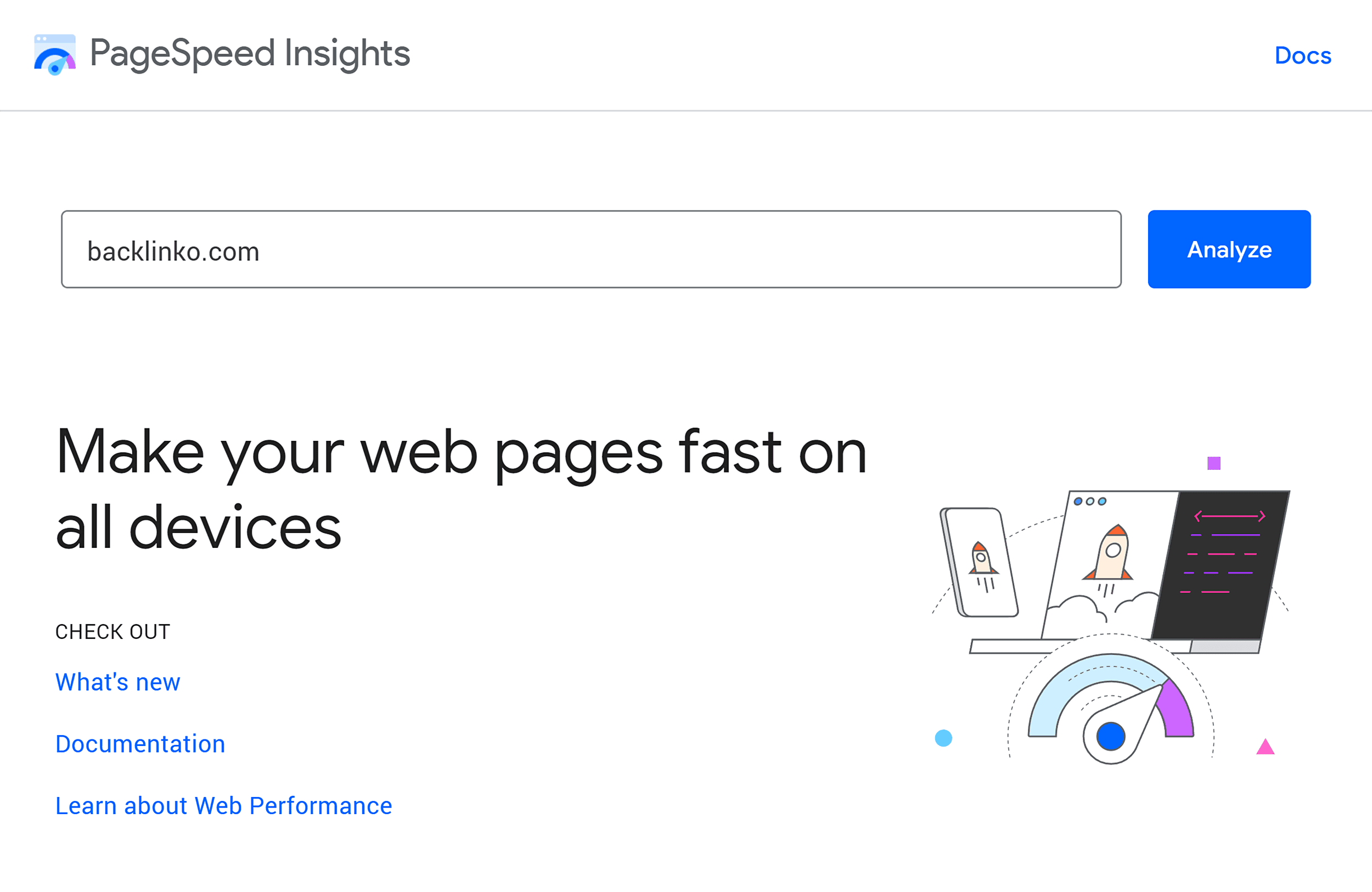
Page speed, also called load speed, tracks how long it takes for the entire content of your webpage to fully load. This has an enormous impact on user experience.
It’s also a confirmed ranking factor for Google. Meaning low page speed can negatively impact your website’s search engine rankings there.
Upon entering your website’s URL, PageSpeed Insights evaluates the load time and efficiency of your site. It provides you with insights like:
Core Web Vitals: Metrics such as Largest Contentful Paint (LCP), First Input Delay (FID), and Cumulative Layout Shift (CLS). Google considers these crucial for the user experience.

Optimization suggestions: Specific advice on improving your page load time. Such as compressing images, reducing unused JavaScript and CSS, and leveraging browser caching.

By addressing these issues, you can significantly improve your website’s user experience. And that can improve your search engine rankings.
Link Building Tools
Link building refers to the process of building backlinks to a site. Backlinks are links on one website that point back to another.
It’s an important part of SEO. Important and distinct enough that we’ve given link building its own section in this article. And recommended list of tools.
Backlinks are worth strategic pursuit because search engines, including Google, consider high-quality backlinks a vote of credibility. Building high-quality backlinks to your website can improve your search engine rankings.
Here are a few link-building tools to consider:
6. Backlink Analytics
Semrush’s Backlink Analytics tool lets you dive deep into the backlink profile of any domain, including your own and those of your competitors.

This is an especially good tool to use because, as of 2021, Semrush has one of the largest backlink databases on the internet today.
Use this tool to track:
Website backlinks: See all the links from other websites that lead to yours or your competitors’ sites.

Referring domains linking to a website: Beyond individual backlinks, Backlink Analytics displays the domains (websites) that link to a site.

Types of backlinks: Backlink Analytics provides valuable insights into the nature of every backlink. It distinguishes between text, image, frame, and form.

Link attributes: Backlink Analytics also shows the attributes of backlinks, which are markers that tell search engines how to consider the link in terms of passing value and influence. Like follow, nofollow, sponsored, or UGC.

You can use all of this information to plan a winning link-building campaign for your business.
Tip: Also, check out Semrush’s Link Building Tool. It lets you manage the entire link-building process holistically (from identifying prospects to communicating with them) all in one place.

7. Help a B2B Writer
Another great way to build backlinks to your website is by sharing your expert input with writers and journalists.
Help a B2B Writer is a platform that connects journalists and content writers with potential sources who are experts in their field. Requests are published for publications of all sizes.

For example, if you have more than 15 years of experience in project management, you can register on Help A B2B Writer as an expert on that topic. Then, when someone is writing a piece on project management and needs expert opinions, they can connect with you to contribute.
In return for your time and expertise, you get credited in their content. This often includes a backlink to a website of your choice.
It’s a great way of building high-quality backlinks to your website.
Note: Help A B2B Writer is focused on business-to-business (B2B). It may not be a great choice if you run a business-to-consumer (B2C) business. Featured (previously Terkel) and Help a Reporter Out (HARO) are great alternatives for B2C businesses.
8. Hunter
Hunter’s database consists of more than 107 million professional email addresses.

It’s a great email outreach platform for several use cases. A popular one is link building.
Some popular features include:
Domain Search
This feature reveals email addresses associated with any domain. Just enter the domain of the company you want to contact.
For example, use Domain Search to find email addresses of a company’s in-house marketers. Reach out to them to discuss link-building opportunities.

Email Finder
Use this feature to discover email addresses of just about any prospect. All you need to provide in the Email Finder is their full name. And company domain.
Then, Hunter will work its magic to find the most likely email address for that person.

Email Verifier
Use the Email Verifier feature to confirm the accuracy of emails at hand. This saves you from email bounces.

Campaigns
The Campaigns feature makes it easy to set up and manage email outreach for link building.

You can use this feature to schedule emails, follow up with your prospects, track your email outreach success, and more.

Email Marketing Tools
According to HubSpot’s 2024 State of Marketing & Trends Report, 33% of marketers use email as an online marketing channel.
Email marketing involves sending emails to engage your target audience. You can run email marketing campaigns to promote your brand, educate your target audience, nurture leads, and share updates with subscribers.
Here are some great email marketing tools you can consider:
9. Mailchimp
Mailchimp is used by millions of people globally, and is a household name in email marketing.

Mailchimp offers:
Over 100 Customizable Templates
Mailchimp offers more than 100 attractive email templates. They address different needs like welcoming new customers, educating your audience, upselling your product or service.
You can customize these templates however you want. By adding or changing color, text, images, and more.

Automated Triggers
Mailchimp also lets you automate your email marketing efforts.

So, whether you want to send welcome emails to new customers or reminder emails for subscription renewals, you can set up automated triggers inside Mailchimp.
Inbox Preview
Use this Mailchimp feature to see how your email will look in different email clients. Like Gmail, Yahoo, and Apple Mail.

Since email elements might display differently across platforms, this feature helps you identify and fix rendering or accessibility issues before they impact the effectiveness of your live campaigns.
Analytics
Track the performance of your email marketing campaigns using Mailchimp’s on-board analytics.
Mailchimp lets you track several metrics. Like email open rates, click-through rates, unsubscribe rates, and more.
You can also customize the reporting dashboard as you see fit.

If you prefer visual data representation, use Mailchimp to view these metrics in a graphical format. This can make it easier to track your campaign’s performance.

10. ActiveCampaign
ActiveCampaign is another popular choice among email marketers.
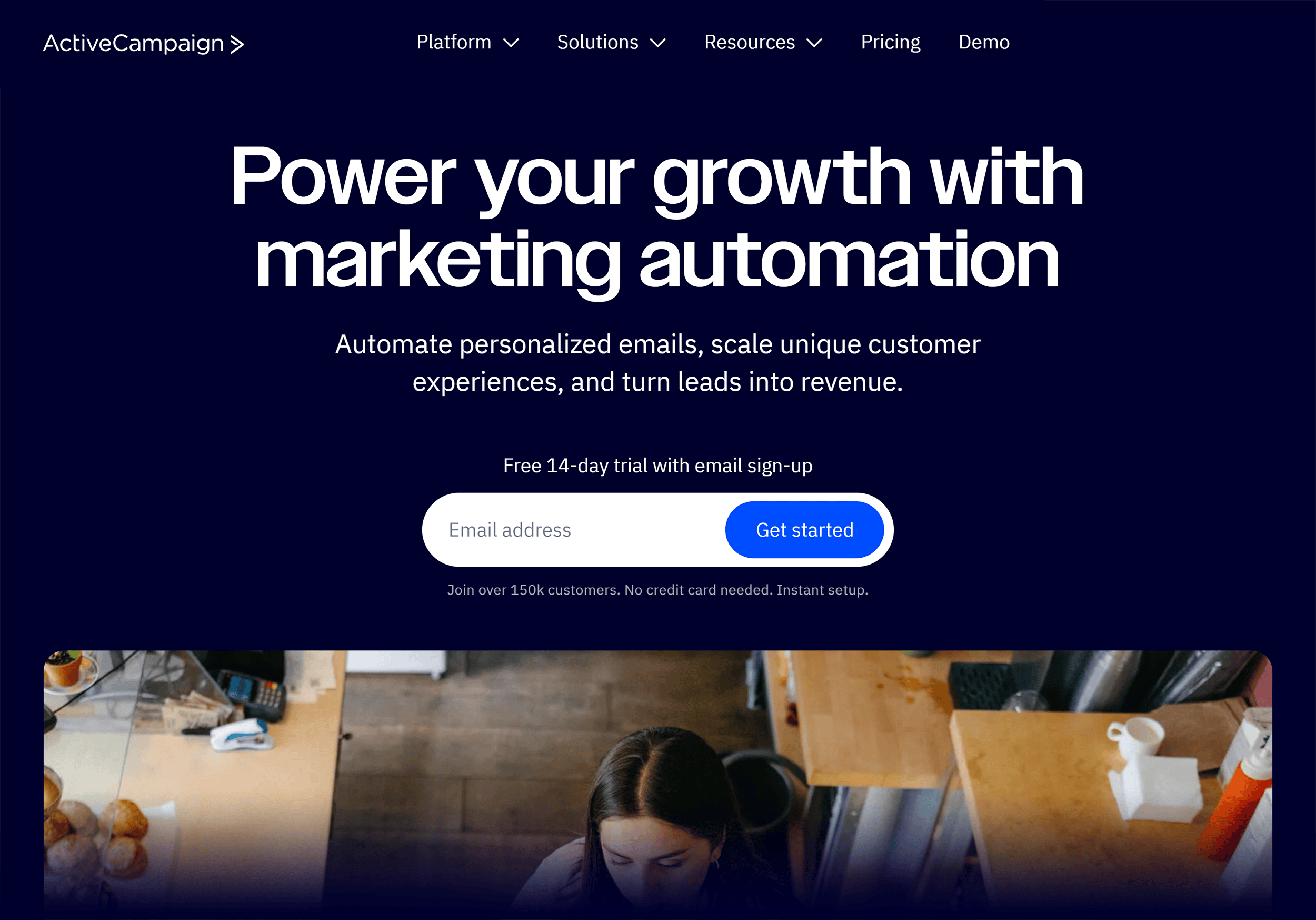
It’s well-known for its powerful automation features. You can automate literally anything—deals, campaigns, ecommerce automation, and more.
Some of its features include:
Pre-Built Automation Templates
ActiveCampaign offers more than 200 pre-built email automation templates.
In ActiveCampaign, the templates are referred to as “recipes.”
The tool has recipes for almost everything. Whether you want to send a reminder email to customers who abandoned their cart or collect feedback from them, ActiveCampaign has a recipe for it.

Automation Builder
ActiveCampaign makes setting up email automation straightforward with its intuitive automation journey builder.
For instance, you might set a workflow to start when a user joins your email list after making a purchase.
You can then apply a tag like “Recent Purchaser” to those users to keep your database organized and make targeted communication easier.
Next, you could delay sending a follow-up email for a couple of days to thank them for their purchase or offer additional products they might like.

With the help of Yes/No branches, you can further tailor the journey, sending different follow-up messages based on whether the user opened the initial email or clicked on a link.
This visualization of the email sequence in ActiveCampaign helps you see the flow of communication clearly, with triggers, tags, and decision points laid out in an easy-to-understand format.
Integrations
ActiveCampaign integrates with more than 900 different marketing software tools. Some of them are even a part of this list. Like Google Analytics and Buffer, for instance.

11. ConvertKit
If you’re a digital creator, ConvertKit can be a great email marketing platform for you. It’s built primarily for creators and offers a wide range of features to help you establish a solid online presence.

Some of its features include:
Email Designer
Use the email designer to build your own email templates using layout blocks. You can also customize design elements easily in the sidebar. Without any HTML coding knowledge required.

ConvertKit lets you save your custom templates in a library, which you can access whenever you create a new broadcast email.
Automation Journey Builder
ConvertKit offers an intuitive visual automation builder to help you build triggered email communications.

Not sure where to start with automation? The platform offers several visual automation templates.
These are highly-customizable. Meaning you can tailor them to precisely fit your specific marketing strategies and subscriber interactions.
Customizable Email Templates
While you can build your own email templates with ConvertKit, the platform also offers several ready-to-use and customizable templates. These help you build visually appealing emails for your creator business.

AI Writing Tools
AI-enabled tools can help you write content faster.
Note: AI writing tools can’t replace human writers. Don’t use AI-generated content as-is. It lacks depth, is often factually inaccurate, and might not align with your brand’s tone and voice. Edit it thoroughly to fix any gaps and add depth.
Some popular AI writing tools include:
12. ChatGPT
Perhaps one of the most familiar AI writing tools available, ChatGPT has revolutionized content creation in so many ways.

Use it to create different forms of content. Like blog posts, ebooks, whitepapers, social media posts, video scripts, and more.
Just enter your prompt into ChatGP, and it will generate a draft based on your instructions.
Here’s an example:

And the result:

Aside from content creation, you can also use ChatGPT for:
- Creating buyer personas
- Performing market research
- Analyzing and extracting insights from large datasets
- Creating code for non-technical marketers
13. Jasper
Even before ChatGPT was introduced, many marketers used Jasper to create content. The tool was formerly known as “Jarvis.”

Jasper offers a variety of templates to get you started. Each with different content formats and structures.

Pick a template, and Jasper will ask you for more information.
For example, if you choose the blog post outline template, you’ll be asked about the title, topic, and tone of voice.

Use Jasper to create different forms of content in a few clicks. Jasper also helps with:
- Rewriting sentences
- Fixing grammatical errors
- Changing your content’s tone of voice
Jasper also offers Jasper Chat, which functions similarly to ChatGPT. Engage in a conversational manner to refine ideas, ask for content suggestions, and even brainstorm ideas or outlines for your articles.
It’s useful for overcoming writer’s block or when you’re looking for a new angle on a topic you’ve covered before.
14. Semrush’s ContentShake AI
Semrush’s ContentShake AI simplifies the entire content-production process, from ideation to final publishing. It can save you time, money, and effort that you’d have otherwise spent on setting up workflows and coordinating tasks manually.

Because of that, it can be especially beneficial for small- and medium-sized businesses with limited budgets that want to speed up their content production.
Once you have identified the best keywords for your business, you can input them into ContentShake AI.

The tool will suggest the article title and target keywords. You can also set the word count, tone of voice, and readability level.

Once you choose the topic, the tool will produce a full-fledged article, which you can directly publish to your blog.

However, we don’t recommend you to publish AI-generated content just as-is. The tool is designed to analyze search intent and seamlessly integrate your target keywords.
Instead, edit it inside the ContentShake AI editor.
You can even create a structured outline for your blog post, based on competitor data. And tweak the outline as needed.

Then pass this basic blog structure to your in-house or freelance writers.

ContentShake AI is integrated with Unsplash. So you can easily search for and add images to your blog post from within the tool interface. It also provides access to AI-generated images.

Additionally, the tool offers SEO suggestions to help optimize your blog posts for search engines.
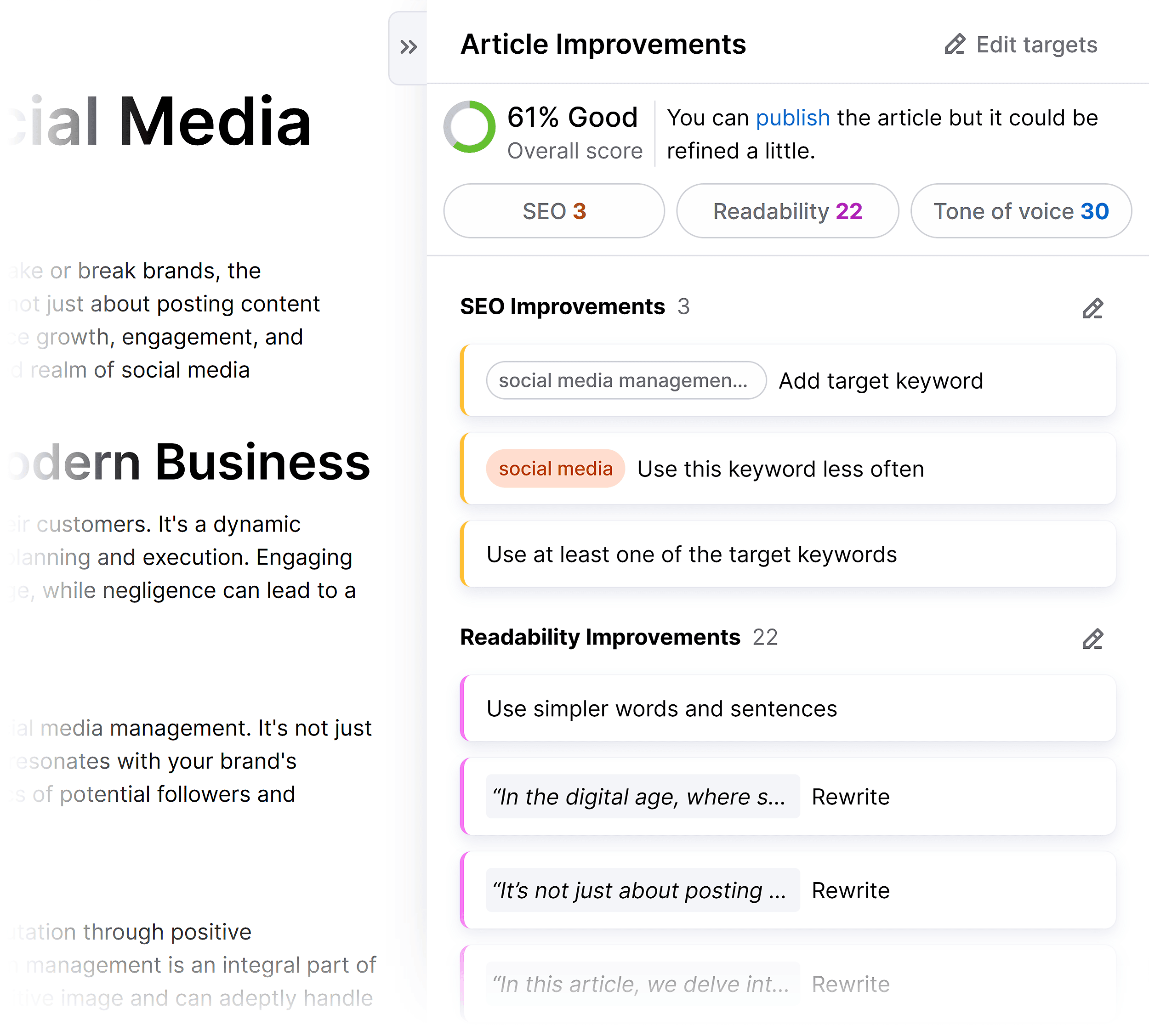
Finally, ContentShake AI enables you to publish your posts directly to WordPress or export them to Google Docs.

You can also use this tool for social media content production.

15. Semrush’s SEO Writing Assistant
Semrush’s ContentShake AI streamlines end-to-end content production. But if you’re just looking to optimize your content for users and search engines, it’s a great idea to use Semrush’s SEO Writing Assistant.

It evaluates your content based on the following parameters:
- Readability: The ease with which your audience can read and understand your content.
- SEO: How well your content is optimized for your target keywords and search engines.
- Tone of voice: The overall tone of your content.
- Originality: Your content’s overall plagiarism risk.

SEO Writing Assistant not only helps improve the SEO ranking of the content, but it also enhances its overall quality, making sure it meets best SEO practices before it even gets published.
16. Wordtune
Wordtune is a popular AI writing assistant for marketers and businesses alike.

Use Wordtune for a variety of purposes. Like:
Rewriting sentences: Wordtune offers several suggestions to help you rewrite your sentences.

Changing your content’s tone and voice: You can switch between a casual and formal tone.

Getting rid of writer’s block: If you’re stuck and need a helping hand while writing, use Wordtune’s contextual suggestions, which let you continue writing, elaborate on a specific point, add examples, etc.

Generate content: You can also use Wordtune to create social media posts, emails, blog posts, job descriptions, product descriptions, technical documentation, and more.

Content Creation and Design Tools
Adding images and videos that complement your content can significantly increase engagement. And deliver more value to your target audience.
Here at Backlinko, we love creating visual content. We have a dedicated design team that makes our content stand out. Shout out to Sasha and Sona.
These are a few of the tools they use:
17. Canva
Canva is one of the most popular online graphic design platforms. Its interface is simple enough that almost anyone can use it to produce high-quality visuals (both images and videos).

Some popular features:
Customizable Templates
Canva offers more than 200,000 customizable templates (free and paid) for a wide range of use cases. Whether you want to create an Instagram post for your fashion brand or a resume for a friend, Canva has you covered.

Drag-and-Drop Functionality
Canva’s drag-and-drop functionality makes it super easy for just about anyone to customize these templates. Even those with no prior graphic design experience.
Select a template that closely matches your vision. Customize it by:
- Adding text
- Changing the font and colors
- Dragging different elements into place
- Adding custom elements like shapes or tables
- Uploading images and logos
An Extensive Media Library
Canva provides access to millions of stock images, illustrations, icons, and videos. Helping you find the right visuals to complement your message.

The platform also integrates with external media libraries like Pexels and Pixabay.
Real-Time Collaboration
Canva lets you collaborate with others in real time. Helping you streamline the review and approval process.

Share your designs with team members or clients. And receive feedback directly in the platform.
18. Remove.bg
Remove.bg is a godsend for marketers and businesses. It can remove any image’s background using AI.

Just upload your image to the platform. The tool will remove the background of that image in seconds.

Remove.bg also lets you manually erase or restore image elements if you require more precision.

19. VEED.IO
What Canva is for graphic design, VEED.IO is for video editing. This platform, with its user-friendly interface, is used by thousands of marketers and businesses. And doesn’t require technical expertise.

It provides access to a wide range of customizable video templates and presets.
Some powerful features:
Magic Cut: Effortlessly trims away unnecessary pauses, filler words, and outtakes from videos.

Audio Cleaner: Enhances your video’s sound quality by eliminating background noise automatically.

AI Background Remover: Replaces your video’s existing backdrop with a background of your choice.

Add image, music, text to video: Uplift your videos with pictures, background music, and text overlays.

Auto subtitles: Generate captions for your videos automatically.

Screen recording: Capture your screen for tutorials, presentations, or any content that requires a visual walkthrough.

Social Media Marketing Tools
Social media marketing involves using social media platforms like Facebook, Instagram, LinkedIn, and X (formerly Twitter) to naturally attract and engage your audience.
Common tasks include:
- Publishing high-quality content on social channels
- Interacting with your target audience via direct messaging, comments, and content engagement
- Tracking social media metrics (likes, comments, shares) to analyze your social media marketing performance
Here are a few social media marketing tools to consider:
Semrush Social Tools
Semrush’s Social Toolkit is a great fit for small- and medium-sized businesses.

It offers several integrated social media marketing tools.
20. Social Poster
This tool lets you draft, schedule, and publish social media content on different platforms from a single dashboard.

21. Social Tracker
Social Tracker allows you to monitor your competitors’ social media activity and engagement on platforms like Instagram, LinkedIn, X, and YouTube.
Compare their engagement and growth with yours directly from Semrush’s interface. Spot trends and strategies your competitors are implementing. This helps you fine-tune your own social media marketing strategy for better results.

22. Social Analytics
Social Analytics makes it easier to measure your social media marketing performance.
It provides a comprehensive overview of your social media performance across different platforms in one place. These insights include reach, engagement rates, and follower growth.

23. Social Inbox
This tool acts as a centralized hub for all your social media interactions. It lets you receive and respond to messages, comments, and mentions from different platforms all in one place.
This streamlines your social media interactions. And helps you engage with your audience efficiently.

24. Buffer
Buffer is another well-reputed social media management platform.

Use Buffer to manage multiple social media accounts seamlessly.

For instance, you can use Buffer to plan, draft, and schedule social media posts across different platforms from a single dashboard.

Another interesting feature of Buffer is the ability to customize and repurpose content to suit the unique requirements of each social platform.
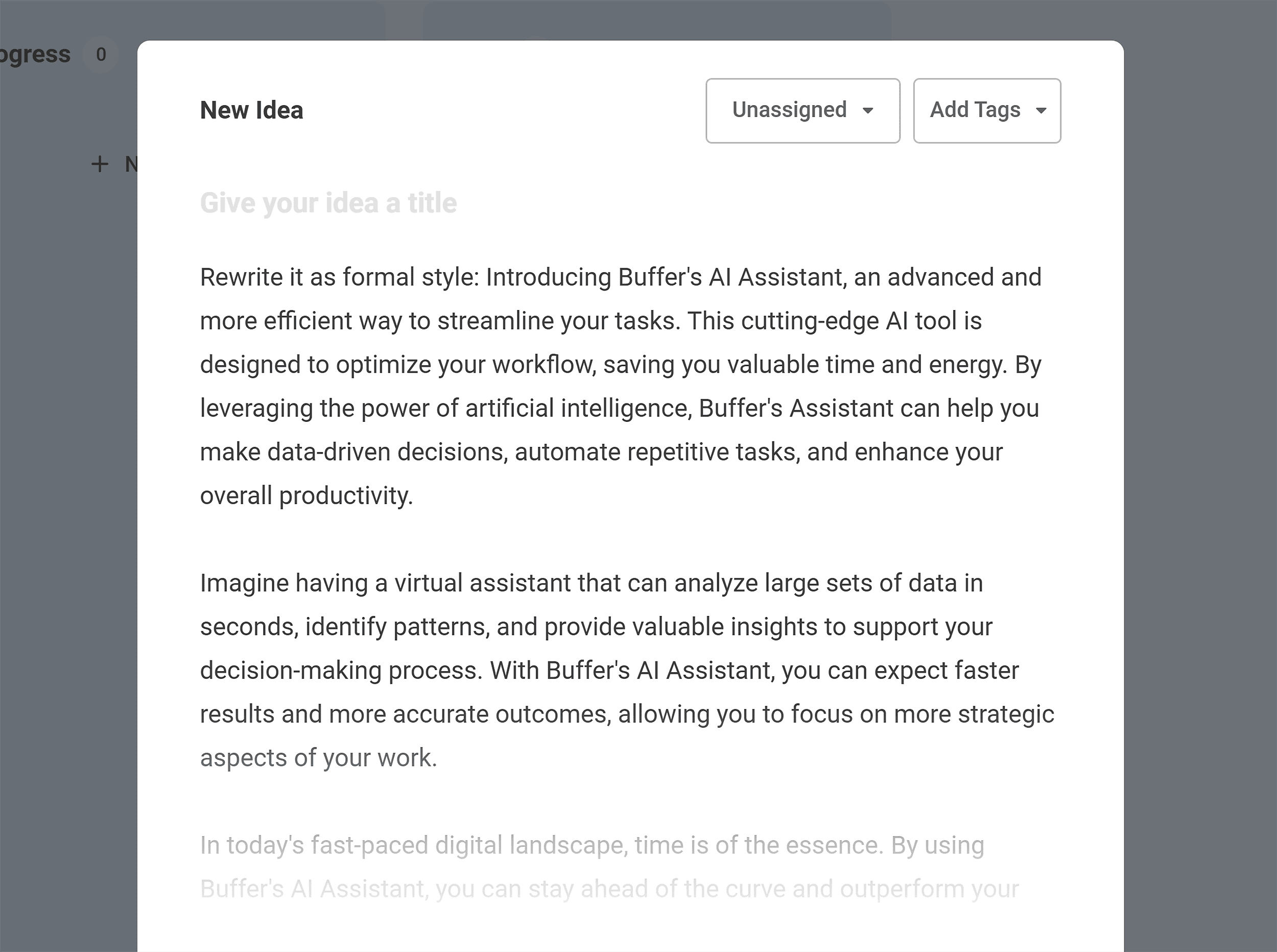
You can collaborate with your team members directly in Buffer by assigning posts, reviewing drafts, and managing permissions.

Another standout feature is the ability to monitor and engage with your audience through comments and messages on various platforms.

Lastly, you can analyze the performance of your posts with detailed analytics and insights directly from Buffer.
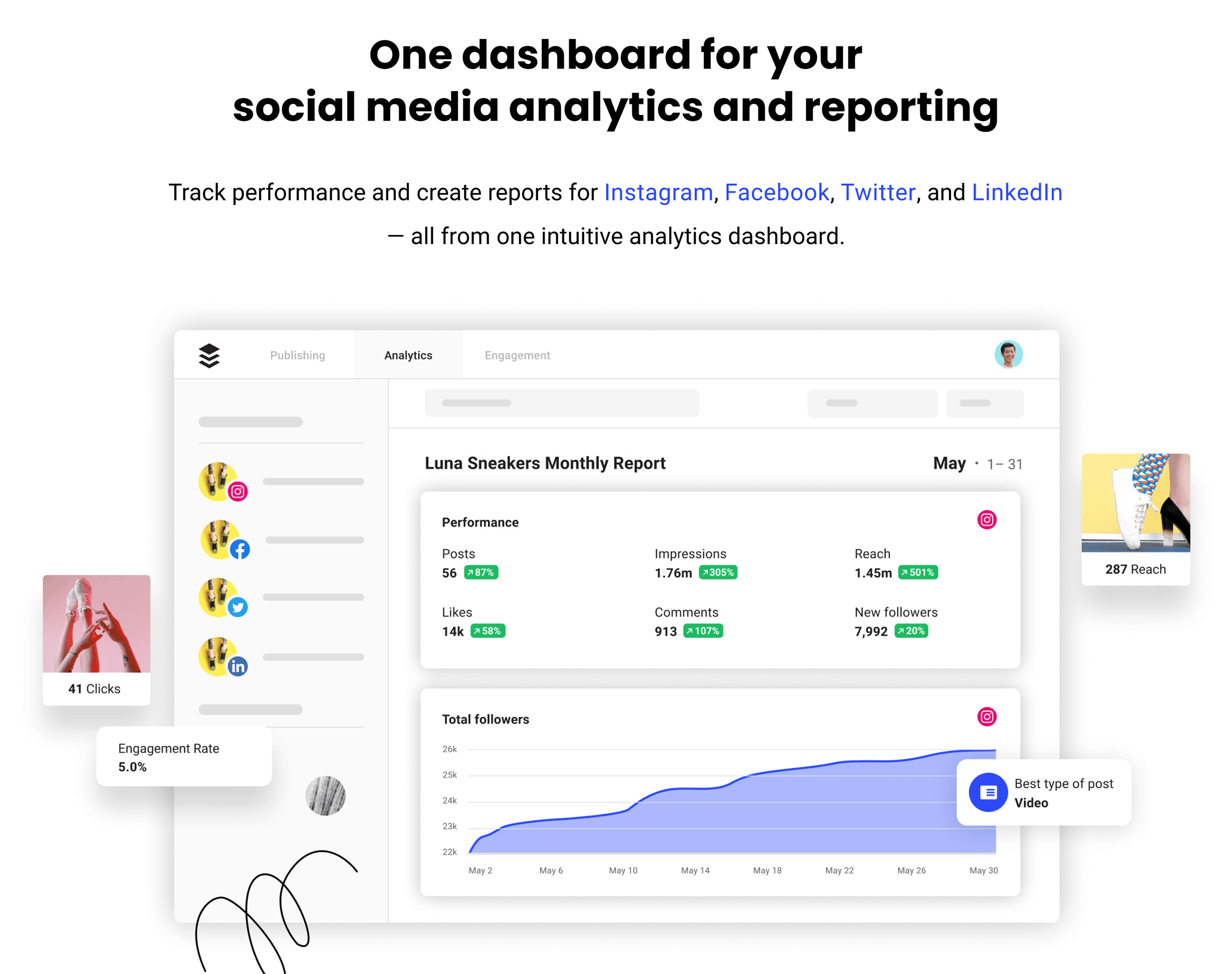
25. Sprout Social
Sprout Social isn’t just a great choice for small- and medium-sized businesses. But also for enterprises.

Sprout Social lets you monitor conversations on social media that are relevant to your brand, industry, and competitors. Helping you stay on top of industry changes and audience sentiments.

It also streamlines team workflows with tools for content planning, approval processes, and task assignments.

Sprout Social makes it easy to manage your social media presence across multiple platforms from a single dashboard.
This includes planning your content calendar, scheduling posts in advance, and publishing across different social media platforms from a single dashboard.

Sprout Social’s holistic management isn’t just for posting on social media. You can also engage with your audience effectively through a unified inbox that consolidates messages, comments, and mentions from all platforms.

Last but not least, you can use the platform to measure your social media marketing performance and generate customizable reports.

Paid Advertising Tools
Paid advertising is the practice of placing paid ads across your preferred platforms to promote your brand. You can run paid ads on search engines, social media platforms, and more.
Here are some paid advertising tools to consider:
26. Meta Ad Library
Use the Meta Ad Library to analyze your competitors’ ads on Meta-owned social media platforms. Like Facebook, Facebook Messenger, and Instagram.

You can search for ads based on keywords.

And you can search by advertisers.

You can also set your preferred location where the ads are being displayed to further narrow down your search.
The Meta Ad Library will show you not only what ads your competitors are currently running but also ads they ran in the past.

For every ad, you can see visuals, text, and calls to action (CTAs).
Exploring the Meta Ad Library is a great way to get inspiration for your own ads.
27. LinkedIn Ad Library
Just like Meta, LinkedIn also offers an Ad Library. There, you can analyze the ads your competitors are running on the platform.

Search for ads by advertiser name, keyword, country, and date range.
Once you perform your search, you’ll see:

You can further analyze every ad’s visuals, text, CTAs, and advertiser and payer names.

Semrush’s Advertising Toolkit
If you want to run paid ads on search engines like Google, Semrush’s Advertising toolkit can be a great fit. It offers tools for different purposes, like market analysis, keyword research, and ad tracking.
Here are some popular ones:
28. Advertising Research
Advertising Research lets you analyze your competitors’ Google Ads strategies. It gives you insights into their ad copy, costs, and keywords.

Just plug in a competitor’s domain into the tool.
Within seconds, the tool will show you valuable information like: The number of keywords they’re bidding on, estimated paid search traffic, and estimated traffic cost.

Then, compare metrics over time under the “Paid Search Trends” section.

Advertising Research also provides comprehensive insights into competitors’ top paid search keywords. Along with valuable information like associated volume, position, cost per click, and traffic.

You can also use this tool to analyze your competitors’ paid ads from the “Ad Copies” section.

Use all of this information as inspiration to create winning paid ad campaigns for your business.
29. PPC Keyword Tool
Use Semrush’s PPC Keyword Tool to find keywords for your paid ad campaigns.

For every keyword, the tool provides you with valuable information like:
- Volume: How many people search for the keyword each month
- Cost per click: An average amount the advertiser would have to pay for each click
- Competitive density: The level of competition (0.00-1.00) between advertisers bidding on a specific keyword

The Best Tools Are Only as Good as Your Strategy
Tools can help you save time and increase sales. But the most powerful tool can’t overcome a terrible marketing strategy.
As you test these tools, spend time developing your digital marketing plan. Your plan will inform which tools you should prioritize.
To help with your planning, read our content marketing guide. It walks you through marketing funnels, content templates, and systems to drive organic traffic to your business.
The post 29 Top Digital Marketing Tools for Every Budget appeared first on Backlinko.



